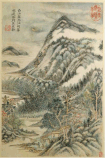The Four Wangs (Chinese: 四王; pinyin: Sì Wáng; Wade–Giles: Ssŭ Wang) were four Chinese landscape painters during the Qing dynasty in the 17th century, all with the surname Wang. They are best known for their accomplishments in shan shui painting.
YouTube Encyclopedic
-
1/3Views:11 3248 5515 826
-
Modern Chinese Painter - 宋文治 Song Wenzhi (part 1)
-
Modern Chinese Painter - 宋文治 Song Wenzhi (part 2)
-
Master of Chinese Painting - Li Keran 李可染 (Part 1/10)
Transcription
The painters
They were Wang Shimin (1592–1680), Wang Jian (1598–1677), Wang Hui (1632–1717) and Wang Yuanqi (1642–1715).[1] They were members of the group known as the Six Masters of the early Qing period.[1]
Philosophy
The Four Wangs represented the so-called "orthodox school" of painting at the time. The school was based on the teachings of Dong Qichang (1555–1636). It was “orthodox” in the Confucian sense that it had continuing traditional modes, as they were in contrast to the "Individualist" painters such as Bada Shanren and Shitao.[2]
See also
References
- ^ a b Cihai: Ci hai bian ji wei yuan hui (辞海编辑委员会). Ci hai (辞海). Shanghai: Shanghai ci shu chu ban she (上海辞书出版社), 1979 Page 757.
- ^ "Four Wangs | Chinese Painting | China Online Museum". www.chinaonlinemuseum.com. Retrieved 2019-12-23.
Further reading
- Fong, Wen C.; et al. (2008). Landscapes clear and radiant: the art of Wang Hui (1632-1717). New York: The Metropolitan Museum of Art. ISBN 9781588392916.
External links
- Four Wangs' Painting Galleries at China Online Museum




